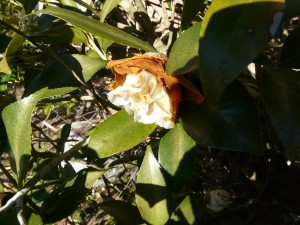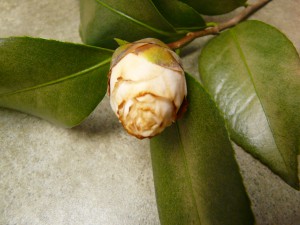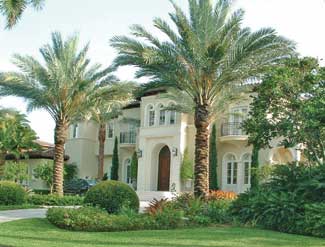
by Sheila Dunning | Jan 20, 2016
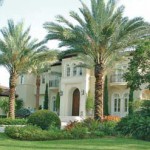 While palms may survive, or even thrive, for years in climates cooler than those to which they are native, eventually they will experience temperatures cold enough to cause injury. Here in Northwest Florida, it was January 2014. Unfortunately, much of the damage was not evident until the summer of 2015. The palms held on with stored food reserves.
While palms may survive, or even thrive, for years in climates cooler than those to which they are native, eventually they will experience temperatures cold enough to cause injury. Here in Northwest Florida, it was January 2014. Unfortunately, much of the damage was not evident until the summer of 2015. The palms held on with stored food reserves.
When cold damage is severe, plant tissues are destroyed and water uptake into the plant may be reduced for years. Many times it is only the protected bud that will remain alive. The stem slowly weakens until it can’t support the weight of the crown and it collapses.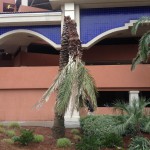
Winter is upon us again. So, if you still have palms in the landscape, be prepared, should we experience some extreme weather. Here’s a reminder of what to do.
One of the most common problems associated with freezes is that the freeze-killed lower portion of the spear leaf is degraded by secondary fungi and bacteria that are always present in our natural environment. Palm owners are often anxious to trim off the damaged leaves following a cold weather event. Avoid the temptation to remove these fronds until danger of additional freezes has passed. Even dead leaves provide insulation to the critical bud.
As the weather warms, the dead fronds need to be removed from around the bud so that the spear can begin to dry out. Drenching the bud area with a copper fungicide will reduce the secondary microbes. Repeat applications will need to continue as the palm leaves develop. Copper fungicides, unlike other fungicides, are active against bacteria and fungi. Be cautious to not use a copper nutrient spray rather than a fungicide. Delay fertilizer application until new fronds have developed. The best analysis for palms is 8-2-12 + 4Mg. Utilization of proper palm fertilization can improve cold hardiness of palms.
Palms damaged by cold can still show symptoms six months to a year following a freeze. New leaves in the spring may appear mis-shaped. Usually the palm will outgrow the damage. However, sometimes the palm loses its ability to take up water. If there is a sudden collapse of the fronds in the crown during the first hot days, the palm may die. There is nothing that can be done to save the palm.
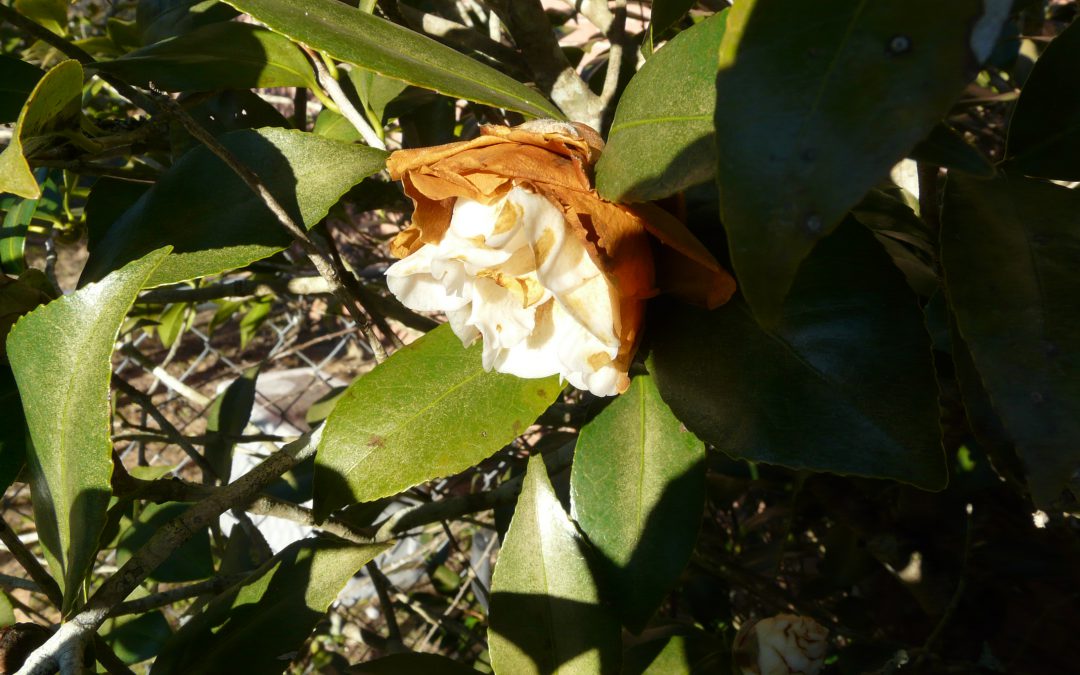
by Larry Williams | Jan 27, 2015
Do you have camellia plants with flower buds that fail to open? Here are possible causes for this problem.
For more information on camellias, contact the UF/IFAS Extension Office in your County or visit http://edis.ifas.ufl.edu/ep002 to access the publication, “Camellias at a Glance.”
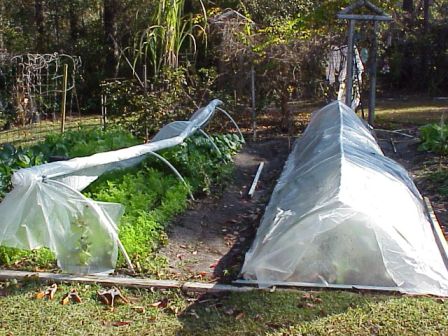
by Eddie Powell | Jan 22, 2015
Florida homeowners enjoy a wide range of landscape and citrus plants and often times desire a tropical or semitropical appearance to their landscapes. Many landscape plants are often planted past their northern limit such as here in Northwest Florida, although microclimates differ dramatically. Tropical and subtropical plants can be used in the landscape, but they must be protected or replaced if necessary during cold weather. A good variety of tender and hardy plants should be planted in order to prevent total devastation of the landscape by extremely cold weather.
The site selection for tender plants should be number one on your list when preparing for a freeze. Tender ornamental plants need a higher site with good air drainage, and not in a low area where cold air settles. Arranging tender plants along fences or other barriers to protect them from cold winds improves the plants’ cold protection, especially from very hard freezes.
Poorly drained soils result in weak shallow roots which are more susceptible to cold injury. Plants grown with the correctly applied rate of nutrients will tolerate colder temperatures better and recover from cold injury faster than plants grown with little or no added nutrients. Be aware that late fall fertilizing of nutrient deficient plants or fertilization before unseasonably warm periods can result in a late growth which is more susceptible to cold injury.
Ornamental plants that are planted under large tree canopies can have more cold protection and require less cold prevention for the owner.
Watering landscape plants before a freeze can help protect plants. A well watered soil will absorb more solar radiation than dry soil and will reradiate heat during the night by as much as 2°F . However, saturated soil conditions can damage the root systems of most plants over a few days, so make sure the ground is well drained.
Avoid late summer or early fall pruning which can alter the plant hormonal balance resulting a flush of new growth. This new growth is more susceptible to cold injury. Healthy plants are more resistant to cold than plants weakened by disease, insect damage, or nematode damage. Routine inspection for pests and implementation of necessary control measures are essential.
Here are a few methods for plant protection. Plants in pots or containers must be moved indoors where heat can be available to them. Containers that have to be left outdoors should be protected by mulches around the container or root ball of plants in the landscape to reduce heat loss from container sidewalls.
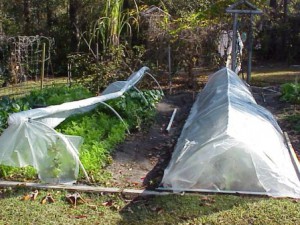
Cold Protection for Veggies!
Coverings can help protect plants more from frost than from extreme cold. Covers that extend to the ground and are not in contact with plant foliage can lessen cold injury to the plant. Foliage in contact with the cover is often cold burned or injured because of heat transfer from the foliage to the colder cover. Some examples of excellent plant covers are cloth sheets, quilts or black plastic. If plastic covering is used, it is extremely important to remove the covering during the day to provide ventilation of trapped heat. A light bulb under a covering also is a simple method of providing heat to ornamental plants in the landscape during the night hours.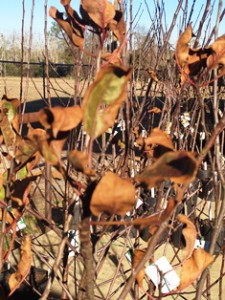 Cold Damage on Fruit Tree
Cold Damage on Fruit Tree
Pictures By Eddie Powell
Immediately after the frigid weather has passed, plants need to be checked for water loss. The foliage could be losing water vapor or transpiring on a sunny day after a freeze while water in the soil or container medium is frozen. Apply water to thaw the soil and provide available water for the plant. Soils or media with high soluble salts should not be allowed to dry out because salts would be concentrated into a small volume of water and can burn plant roots. Root burn can cause the roots to dry out and not take up water to the plant.
Pruning should be delayed until freezing temperatures have risen or until new growth appears to ensure that live wood is not removed. Dead, unsightly leaves may be removed as soon as they turn brown after a freeze if a high level of maintenance is desired. But it is best to wait until the threat of freezing weather is gone. Cold injury may appear as a lack of spring bud break on a portion or all of the plant, or as an overall weak appearance. Cold injury is usually found in the upper portion of the plant. Branch tips may be damaged while older wood underneath is free of injury. Cold injured wood can be identified by examining the cambium layer under the bark for black or brown coloration. Prune these branches back to a bud 2-3 inches behind the point of discoloration.
For more information on freeze protection of plants see:
Cold Protection of Landscape Plants
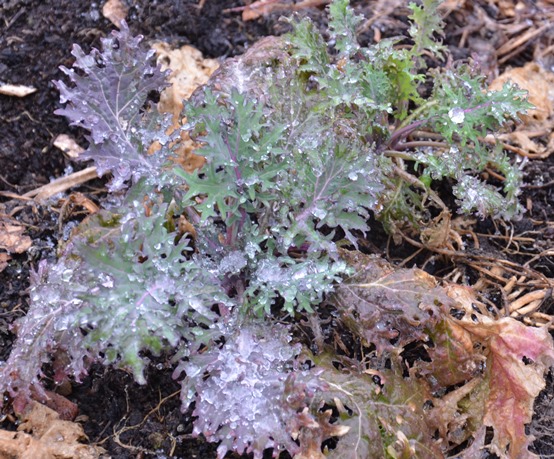
by Les Harrison | Dec 16, 2014

Some plants will handle freeze events, while other will wither and die. Advance preparation will improve chances of saving sensitive plants from subfreezing weather.
Panhandle Florida gardeners face a new set of challenges annually dealing with the effects of cold weather. A little planning and creativity can make plant protection in the landscape successful.
Many homeowners and landscape managers want to know when plants will need protection. Depending on the plant, a frost warning is a good rule of thumb.
Note there is a difference in the terms used for cold weather conditions. Frost, freeze and hard freeze all describe different circumstances.
Frost is when water vapour freezes on surfaces. It happens on clear nights with still air and may even happen when temperatures are above freezing.
Freezing is when cold air moves in and causes temperatures to drop below 32 degrees Fahrenheit. This condition commonly involves low humidity and wind, making drying out a big problem for plants.
A hard freeze is when temperatures dip below 28 degrees Fahrenheit. Many tropical plants and fruit trees will survive a few degrees below freezing for brief periods, but extended periods of freeze or heavy frost may require lights or other heat used safely with a cover.
Many time freeze damage happens during the busy holiday season. People are busy, schedules are disrupted and the distractions, pleasant thought they be, may cause homeowners to miss a freeze alert.
A few simple actions can save these “green” friends for another year’s enjoyment. Some plants can be moved indoors for the winter and incorporated into the interior décor, rather than cramming them last-minute into a clutter when a freeze looms.
Identify old sheets, blankets and drop cloths which can be used as covers for tender plants which must remain outside. Test potential covers beforehand to assure all plants are thoroughly covered.
It is best if the covers enclose the plant entirely without crushing it. Heavy blankets are great insulation, but only a good idea on sturdy plants.
A tomato cage or other support structure can be used to keep weight off the plant. Covers also need to be secured at the ground with pins or weights to assure cold air does not creep in from below.
Finally, keep storage bins handy and remove the covers in the daytime if temperatures are above 55 degrees Fahrenheit.
Monitor weather reports and react accordingly so tender and tropical plants see another spring in a few more months.
To learn more about protecting delicate plants, see “Cold Protection for Landscape Plants”.
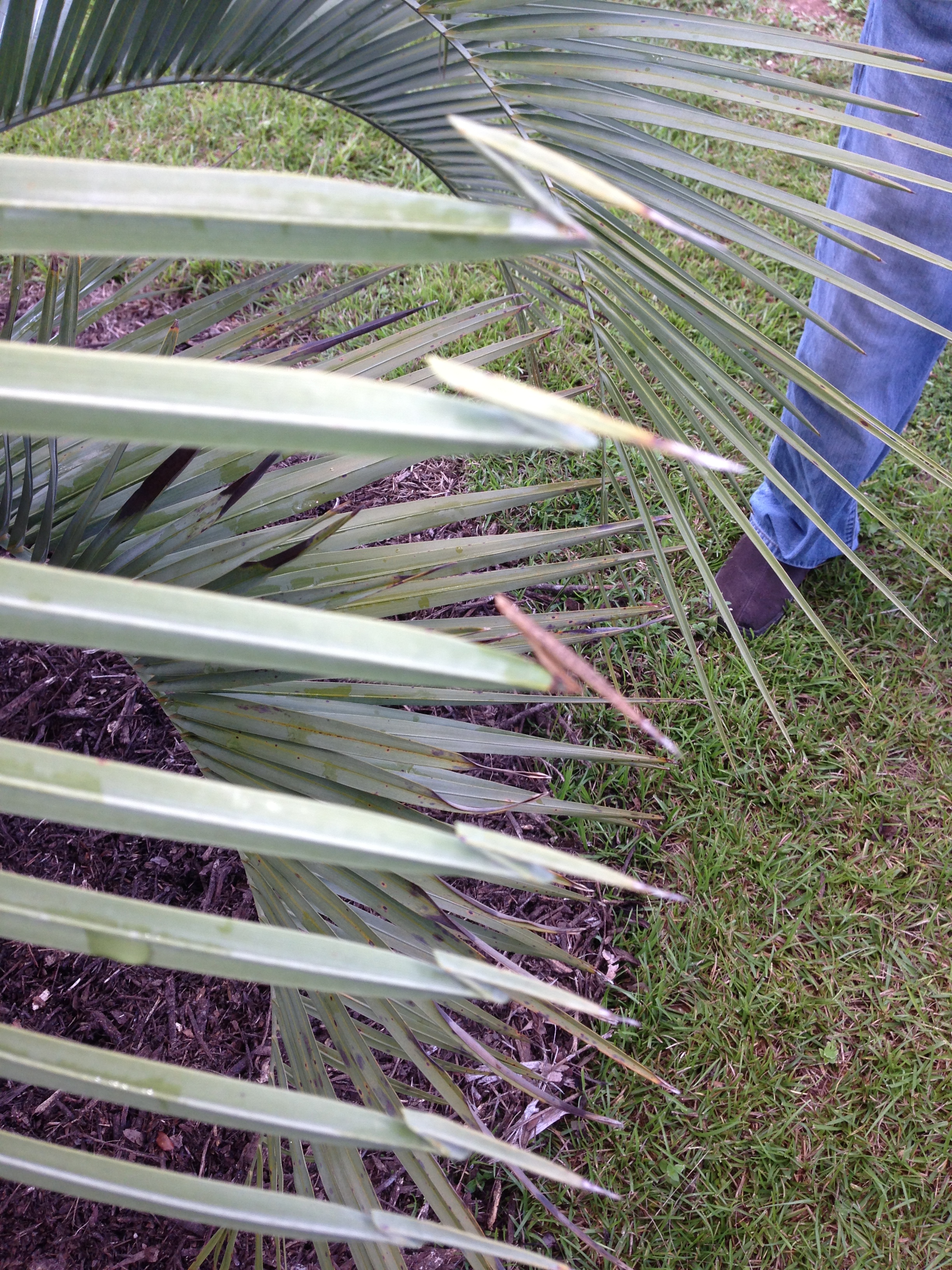
by Blake Thaxton | May 6, 2014
Palms can be difficult to manage in Northwest Florida. To have healthy palms it is important to think about possible cold temperatures, disease, and nutrient needs of palms. The panhandle of Florida was blasted with cold this winter and it is easy to see the effects on the palms. There are many palms throughout Northwest Florida which appear or are dead. This article will give information on several of the pesky palm problems observed throughout the region and some recommendations to help!
Cold damage is evident right now from this past winters’ very harsh temperatures. Some recommendations to help alleviate this problem include selection of the proper species. Some palms are not suited for colder temperatures and this must be taken in to account or you will continue to have problems even during mild winters. Look at the publication that has a table of palm suited for north Florida: Palms for North Florida
Next, develop a plan of action if your palm has been effected by cold damage. As has been seen throughout the panhandle, freeze damage can make an entire palm canopy turn brown and desiccate (dry out). It can even go as far as killing the spear leaf (The newly emerging palm leaf that resembles a spear). Even if the spear leaf has died and easily pulls out of the canopy, the palm may not be dead. If the meristem (the area of replicating cells that new leaves emerge from) survives the palm will also survive. If the spear leaf does die, give the palm 5-6 months to send out a new leaf before declaring it dead.
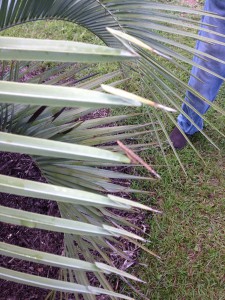
Hook-Leaf caused by an acute Boron deficiency
Another issue that may arise in the near future with the recent heavy rains is Boron deficiency of palms. Boron deficiency can be cause by leaching of soil Boron out of the root zone by heavy rain falls or heavy irrigation. When Boron has been leached from the soil it causes an acute (temporary) deficiency that will only last until microorganisms have time to break down more soil organic material that releases more Boron to the palm. Symptoms include small and crumpled new leaves, angular leaf tips, “hook-leaf”, and sometimes the stem bends sharply to one side. The symptoms won’t be visible for 4 to 5 months as the deficiency affects the leaf during development prior to its emergence. By the time it is seen the problem has probably already been corrected.
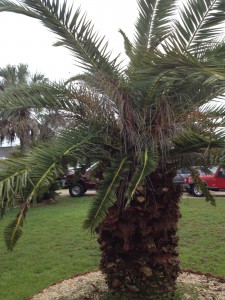
Chronic Boron Deficiency
Also, chronic (long-lasting) Boron deficiency problems can occur on palms. This deficiency is usually caused by soil drying and high soil pH. If there is a chronic Boron deficiency a drench can be applied to correct the problem. Learn more about Boron Deficiency of Palms

 While palms may survive, or even thrive, for years in climates cooler than those to which they are native, eventually they will experience temperatures cold enough to cause injury. Here in Northwest Florida, it was January 2014. Unfortunately, much of the damage was not evident until the summer of 2015. The palms held on with stored food reserves.
While palms may survive, or even thrive, for years in climates cooler than those to which they are native, eventually they will experience temperatures cold enough to cause injury. Here in Northwest Florida, it was January 2014. Unfortunately, much of the damage was not evident until the summer of 2015. The palms held on with stored food reserves.


